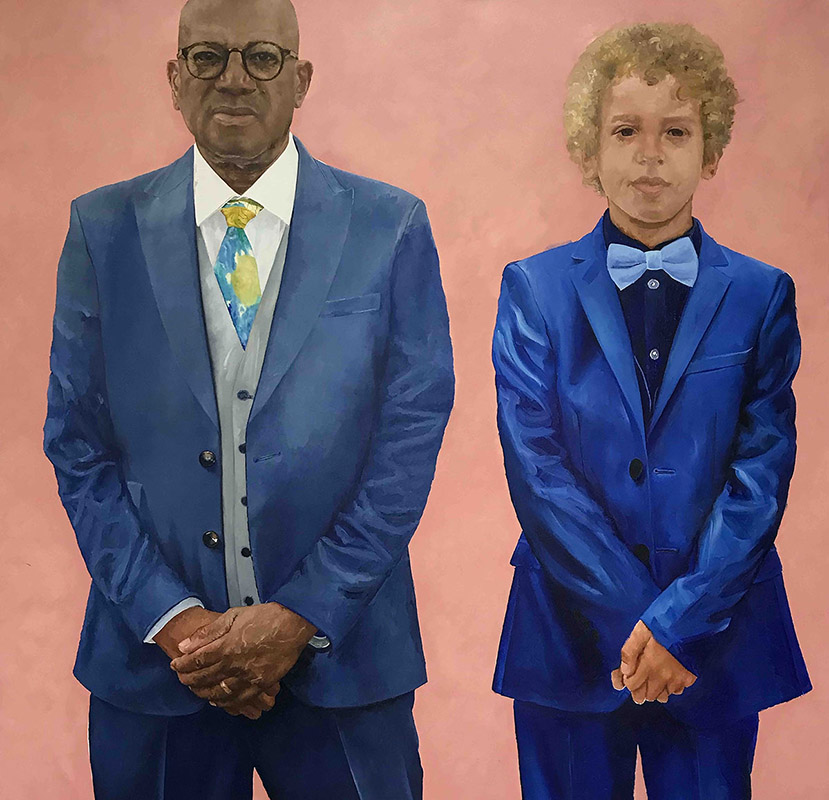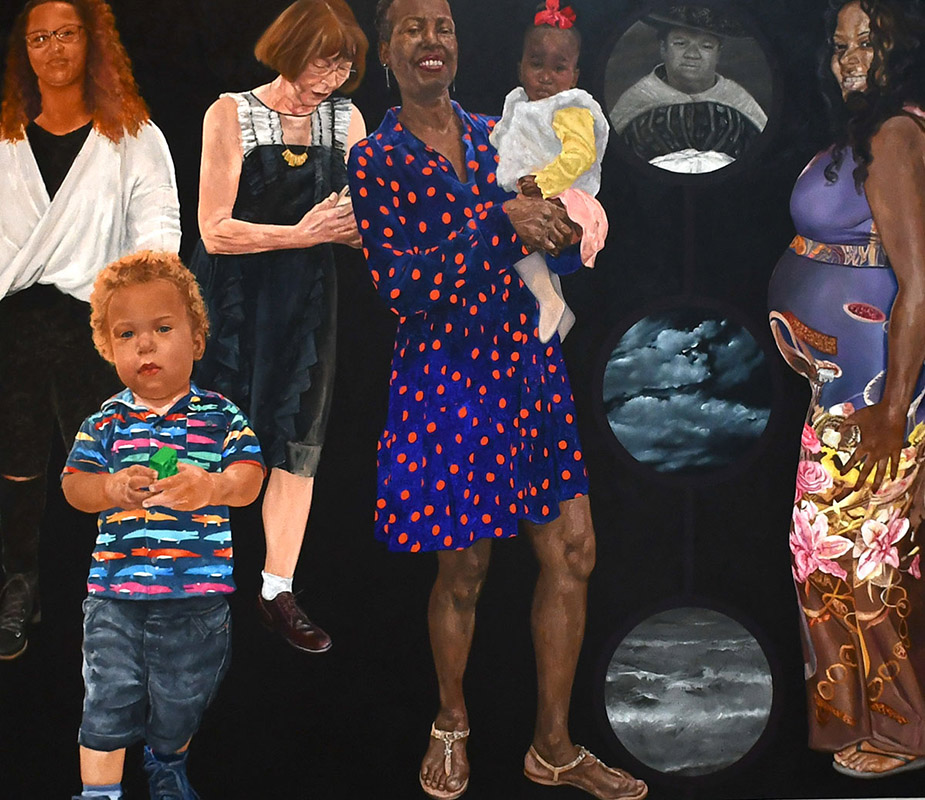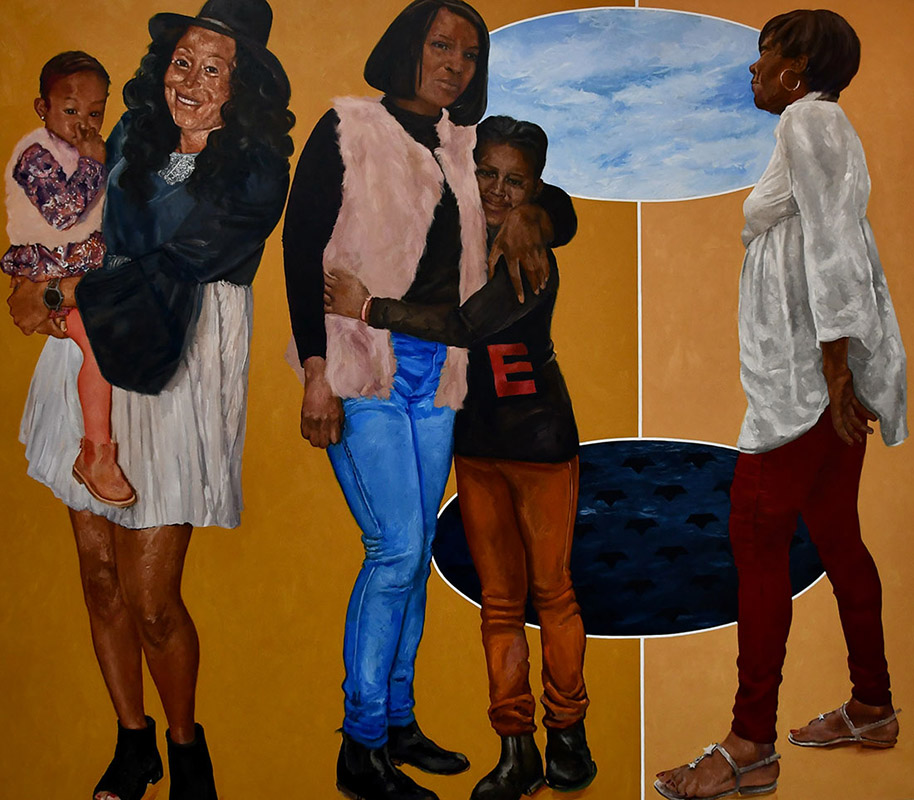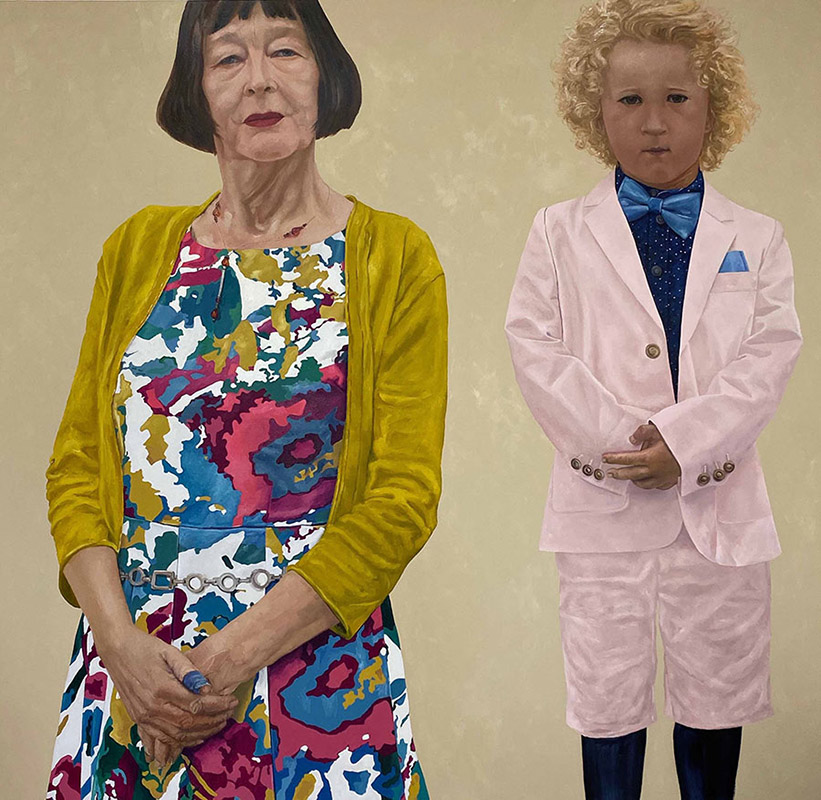Edited by Sandra Crisp LG
Sandra Crisp LG: “Within your practice figurative painting is used to explore the British black diaspora. Archival images and family photographs have been at the core of your practice since the 1980s and formed the starting point for the series of paintings included in a solo exhibition at Wolverhampton Art Gallery, 18 February 2023 – 8 May 2023.
Art historian Eddie Chambers wrote: “Eugene has sought to paint his subjects in challenging, considered and sensitive ways. His paintings are not simply ‘about’ the personalities of the individuals – some family members, some not – that the artist takes as the subject matter for his portraits.” He also mentions the use of classical elements in your portraits which are rendered in a ‘highly finished stylism’.
It will be really interesting to hear your thoughts about painting in more detail. ”

Oil on canvas
176cm X 172cm
2021
In his essay, ‘Cultural Identity and Diaspora’ [1], Stuart Hall re-invigorates the language with which we make sense of ‘painting’ as a practice, a practice that can convey issues about cultural identity and representation in a way that is embedded in the ‘process’ itself. He proposes two ways to think about ‘cultural identity’ and ‘representation’. The first is in terms of shared culture, collective histories, and narratives. In the second sense he proposes a more contemporary explanation of identity; as ‘becoming’ as well as ‘being’. Where the process of making ‘by hand’; transforming, over time, the blank canvas from nothing to something, speaks of this ‘becoming something’- ‘being’.
This reading of identity belonging to the future as much as to the past, invites an imaginative process whereby issues of identity and representation can be tested through visual art practice.
I am interested in finding ways, through painting, to explore the post-colonial mark on ‘Blackness’ based on my own experiences. Embracing the unique position I hold, as an art practitioner embedded in European culture, while remaining symbolically outside of it due to the colour of my skin.
Does engaging with Painting this way, tasking it to ‘convey’ ideas about identity and representation, risk losing sight of the subject of painting itself, its processes, its identity? To what extent does this tasking close out its historical narrative(s) and does it matter? Is the answer to be found in the works themselves?
I find that I am as interested in painting’s history, its controversy of status, its narrative persistence as I am to engage with the processes essential to the forming of each object, each creative outcome.

Oil on canvas
222cm X 196cm
2023

Oil on canvas
222cm X 196cm
2021
I am interested in the interplay of constituent materials that form the work, the paint, its malleability, the mark with all its potential velocities, colour and light. Articulation: the trace of the hand, gesture, and how it reveals itself in the action of becoming, conjuring meaning out of material. In his essay ‘Painting out of Reticence FOIL 2000’ [2] Michael Philipson writes about this incidence of materials at the painting’s surface; “that which is beyond the surface can only be envisioned by just this surface in all its illusive particularity”. He foregrounds painting’s materiality here, by drawing our attention to the substance of painting; its body, its medium, but is he also inviting the reader to consider what else is contained there, ‘its illusive particularity’ the trace of the hand, the gesture? The evocation of painting’s temporal properties, its persistent recalling of its making across time? In my ongoing project as a painter, I want to acknowledge that the social and political landscape of our times, call for the relationship between art, (Painting in this instance) and its audience(s) to be reassessed; a rethinking of what artists do and make, the terms by which artists operate, to bring meaningful understanding to art and the artists’ role(s) in society. I aim to continue my investigation into the potentialities for ‘Painting’ in all its ‘illusive particularities,’ while concurrently, exploring the ways that painting operates in the public sphere—for whom, in what form, and by what means, and to what arguments it can critically contribute.
The success or failure of the work as a ‘body’ depends on how deftly issues of race and representation can be explored while resisting didacticism, the closing out of ‘reading(s)’.
“There is a quiet, understated dignity in this work. Similarly, within it, there lies depth, humanity, and empathy. Palmer’s work reminds us of artists such as he seems almost effortlessly able to combine artistic skill with new and refreshing ways of discussing the Black image, particularly where the image intersects with issues of art history and contemporary identity”. Dr Richard Hylton Lecturer in Contemporary Art at SOAS, London.
“Eugene’s paintings have never depicted Black people within didactic or clumsy political terms of reference. Similarly, he has been effortlessly able to steer clear of the sentimental and the uncritical in his depictions and portrayals of Black people. Instead, within the realm of portraiture, Eugene has sought to paint his subjects in challenging, considered and sensitive ways.” Dr Eddie Chambers Professor, in the Department of Art and Art History, at the University of Texas at Austin, teaching visual arts of the African Diaspora.

Oil on canvas
176cm X 172cm
2021

Oil on canvas
176cm X 172cm
2021
Eugene Palmer LG, 2023
Eugene Palmer is represented by Ed Cross Fine Art
eugenepalmer.co.uk
1. Cultural Identity and Diaspora, Stuart Hall, 1996, Cambridge Polity Press. ISBN 9780761954323
2. Painting out of Reticence, Michael Philipson, 2000, catalogue essay for Foil group travelling exhibition

Oil on canvas
240cm X 150cm
2021

Oil on canvas
240cm X 150cm
2021






